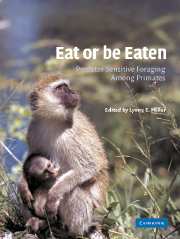Book contents
- Frontmatter
- Contents
- List of contributors
- Preface
- 1 An introduction to predator sensitive foraging
- PART I BIOLOGICAL VARIABLES
- 2 Dangers in the dark: Are some nocturnal primates afraid of the dark?
- 3 Predation sensitive foraging in captive tamarins
- 4 Seeing red: Consequence of individual differences in color vision in callitrichid primates
- 5 Predator sensitive foraging in Thomas langurs
- PART II SOCIAL VARIABLES
- PART III ENVIRONMENTAL VARIABLES
- Index
2 - Dangers in the dark: Are some nocturnal primates afraid of the dark?
Published online by Cambridge University Press: 10 November 2009
- Frontmatter
- Contents
- List of contributors
- Preface
- 1 An introduction to predator sensitive foraging
- PART I BIOLOGICAL VARIABLES
- 2 Dangers in the dark: Are some nocturnal primates afraid of the dark?
- 3 Predation sensitive foraging in captive tamarins
- 4 Seeing red: Consequence of individual differences in color vision in callitrichid primates
- 5 Predator sensitive foraging in Thomas langurs
- PART II SOCIAL VARIABLES
- PART III ENVIRONMENTAL VARIABLES
- Index
Summary
Introduction
The vital life functions of animals dictate that they must obtain energy, avoid becoming an energy source for other organisms and convert energy into the next generation. Avoiding becoming an energy source involves defense against three major categories of threat: (a) parasites and diseases, (b) temperature stress and other environmental hazards and (c) predators (Dunbar 1977). The interactions between these variables may be very complex. Here we focus on the question of how the foraging patterns of nocturnal primates may be influenced by predation risk. Data come from long-term field studies of two species, the Mysore slender loris (Loris tardigradus lydekkerianus) from India and the southern lesser galago (Galago moholi) from South Africa (Fig. 2.1). Direct evidence of predation is very rare, especially at night, so we examine three indirect measures of risk. First, what are the likely predators in each study area? Second, how does each species react to potential predators at night (predator defense)? Third, to what extent do they appear to avoid detection (crypsis)? We then address whether or not there is evidence for an effect on food intake or foraging decisions.
Mysore slender lorises and southern lesser galagos diverge considerably in their methods of locomotion but both species live in relatively open thorn tree habitats that force them to cross open spaces on the ground. Slender lorises are unable to jump and they generally remain below 3 m and cross between trees by stretching and bridging. They rarely descend to the ground (less than three times per hour) where they walk quadrupedally. Lesser galagos, in comparison, are specialized leapers, covering up to 5 m in one bound, as well as walking and running along branches.
- Type
- Chapter
- Information
- Eat or be EatenPredator Sensitive Foraging Among Primates, pp. 21 - 43Publisher: Cambridge University PressPrint publication year: 2002
- 31
- Cited by



